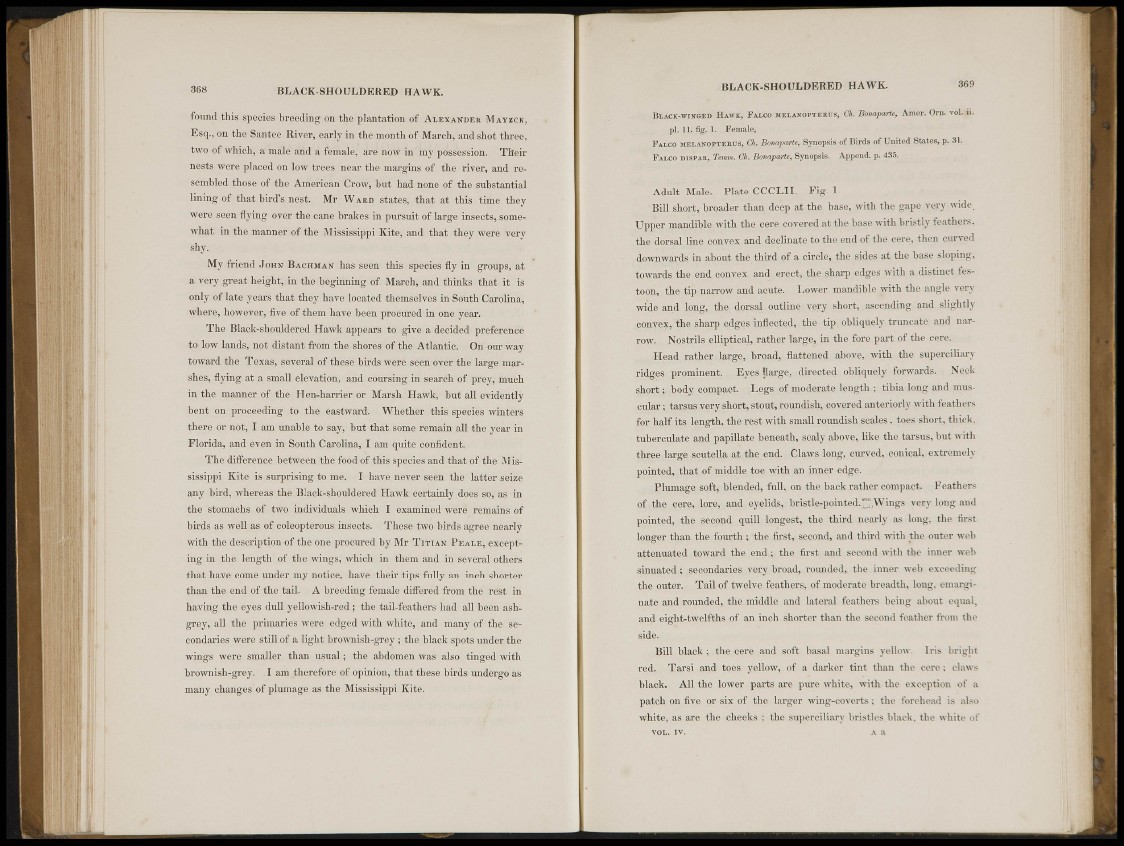
368 B L A C K - S H O U L D E R E D H AWK .
found this species breeding on the plantation of Al e x ande r Mavzc-k,
Esq, , on the Santee River, early in the month of March, and shot three,
two of which, a male' aMd a female, i r e now in my possession. Their
nests wore placed on low trees near the margins of the river, and resembled
those of the American Crow, but had none of the substantial
lining of that bird's nest; Mr Wa r d states, that at this time they
were seen flying over the cane brakes in pursuit of large insects, somewhat
in the manner of the Mississippi Kit»-, and that they were very
l i p . ' « ,
My friend John Kaìtimax lias seen this species fly in groups, at
a very great, height, in the beginning, of March, and thinks that it is
only of late year» that thoy have located themselves in South Carolina,
where, however, five of the>tn have been procured in one year,
.a B h « Hliick-shouldered Hawk appears to give a decided preference
to low lands, not distant from the shore* of the Atlantic. On our way
toward the Texas , several of these bird« were soon over the large marshes,
living at a small elevation, and coursing in search of prey, much
in the manner of the Hen-harrier or Marsh Hawk, but all evidently
bent on proceeding the eastward. Whether this species winters
there or not, I am unable to say, but that some remain all the year in
Florida, and even in South Carolina, I am quite confident.
The difference between the food of this species and that of the Mississippi
Kite is surprising to me. *'I#jhavo never seen the latter seize
any bird, whereas the Black-shouldered I lawk certainly does so, as in
the stomachs of two'individuals which I examined were remains of
birds as well as of coleopterous insects. These two birds agree nearly
with the description of the one procured by Mr Ti t i a n Pe a e e , excepting
in the length of the wings, which in them and in several others
that have come under my notice, have their tips fully an inch shorter
than the end of the tail. A breeding female differed from the rest in
having the eyes dull yellowish-red ; the tail feathers had all been ashgrey,
all the primaries were edged with white, and many of the secondaries
were still of a light brownish-grey ; the black spots under the
wings were smaller than usual ; the abdomen was also tinged With
brownish-grey. I am therefore of opinion, that these birds undergo as
many changes of plumage as the Mississippi Kite.
B L A C K - S H O U L D E R E D H A W K 369
lit.ACK-wrxr.Kn Hawk, Fjelco mki.a.novtkkiis, (Sh. Bonaparte, Amer. Om vol. ii.
j,l. 11, 1. Female, ,
Falco MKi.AXdPTKRrs, Ch. Ihnapartf; Synopsis of Birds of United States, p. 31.
Falco dispaji, Tenrn. Ch. Bonaparte, Synopsis. Append, p. 435.
Adult Male. Plate CCCLI I . Fig. 1.
Bill short, broader than deep at the. base, with the gape very wide.
Upper mandible with the. cere covered at the base with bristly feathers,
the dorsal lino convex and decimate to the end of the cere, then curved
downwards i n about the third of a, circle, the sides at. the base sloping,
towards the end convex and erect., the sharp edges with a distinct festoon,
the tip narrow and acute.., ¿I,ower mandible with the angle very
wide and long^ the dorsal outline very short, ascending and slightly
convex, the sharp edges, inflected, the tip, obliquely truncate and narrow,
Nostrils elliptical, rather large, in the fore part of the cere-
Head rather large, broad, flattened above, with the superciliary
ridges prominent. Kyos ¡large, directed obliquely forwards. Neck
short; body compact, l.egs of moderate length ; tibia long and muscular
; . tarsus very short, stout, roundish, covered anteriorly with feathers
for half its length, the rest with small roundish scales, toes short, thick,
tuberculate: and papillate beneath, scaly above, like the tarsus, but with
three large seutella at the end. Claws long, curved, conical, extremely
pointed, that of middle, toe with an inner edge,
Plumage, soft, blended, full, on the back rather compact. Feathers
of the eere, lore, and eyelids, bristleTp.ointed.™;Wings very long and
pointed, the -second quill longest, the third nearly as long, the first
longer than the fourth ; the first, second, and third with the outer web
ai|t,(Muate,d toward the end.; the first and second with the inner w.eb
sinuated ; secondaries very broad, rounded, the inner web exceeding
the outer. Tail of twelve feathers, of moderate breadth, long, ernarginate
and rounded, the middle and lateral feathers being about equal,
and eight-twelfths of an inch shorter than the second feather from the
side.
Bill black ; the cere and soft basal margins yellow. Iris bright
red. Tar s i and toes yellow, of a darker tint than the cere; claws
black. All the lower parts are pure white, with the exception of a
patch on five or six of the larger wing-coverts ; the forehead is also
white, as are the cheeks ; the superciliary bristles.black, the white of
vol.. TV. a a